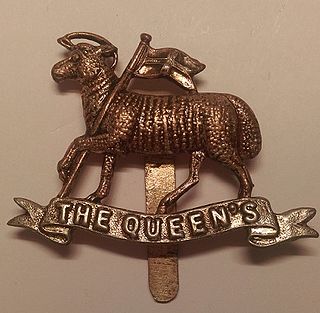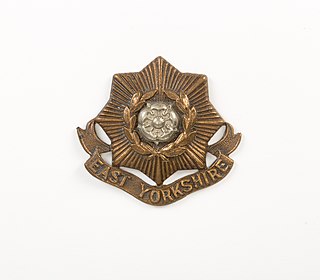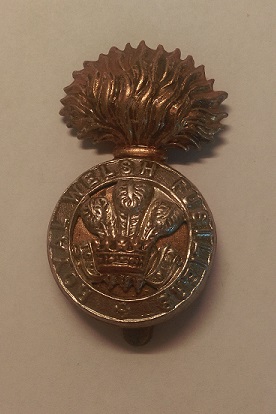
The Queen's Royal Regiment (West Surrey) was a line infantry regiment of the English and later the British Army from 1661 to 1959. It was the senior English line infantry regiment of the British Army, behind only the Royal Scots in the British Army line infantry order of precedence.

The 17th Battalion, The London Regiment , was a unit of Britain's Territorial Force formed in 1908 from Volunteer corps dating back to 1859. It saw considerable service on the Western Front, at Salonika and in Palestine during the First World War. It served as a motorised infantry regiment during the Second World War before conversion to an artillery unit in 1947 and subsequent amalgamation in 1967.
The 1st Northamptonshire Rifle Volunteers were a unit of the British Army raised from 1859 onwards as a group of originally separate Rifle Volunteer Corps (RVCs). They later became the 4th Volunteer Battalion of the Northamptonshire Regiment and saw action in the Gallipoli and Palestine campaigns during the First World War. Converted into a searchlight unit between the wars, they served in the defence of the United Kingdom and as an infantry regiment in liberated Norway during the Second World War. Postwar they continued in the air defence role until 1961 when they reverted to infantry as part of the Royal Anglian Regiment.

The Rangers was a volunteer unit of the British Army, originally formed in 1860. It provided a detachment for service in the Second Boer War, saw intensive action on the Western Front in the First World War, and served as motorised infantry during the Second World War during the campaigns in Greece and the Western Desert.
The 4th Battalion, Queen's Royal Regiment was a volunteer unit of the British Army from 1859 to 1961. Beginning from small independent units recruited in the South London suburbs, it was attached to the Queen's Royal Regiment and served in the Second Boer War, the First World War, and the Third Anglo-Afghan War. Before the Second World War, it was converted into a Royal Artillery searchlight regiment that served in the Battle of Britain and The Blitz. Later it became a light anti-aircraft gun unit serving on blockships in the Mulberry harbour during the Normandy invasion, and then defended the port of Antwerp in the closing stages of the war. Postwar it continued in the air defence role before rejoining the Queen's Regiment as infantry.
The 1st Battalion, London Regiment was a volunteer unit of the British Army under various titles from its foundation in 1859 in Bloomsbury, London, by the author of Tom Brown's Schooldays. It served in Malta, Gallipoli, Egypt and on the Western Front during World War I. In World War II it saw service in Iraq, North Africa and Italy. It amalgamated with other Territorial units of the Royal Fusiliers in the 1960s.
The 2nd Battalion, London Regiment was a volunteer infantry battalion of the British Army under various titles from 1860 to 1961. It served in Malta, Gallipoli, Egypt and on the Western Front during World War I. In World War II it saw service in Iraq, North Africa and Italy. After a postwar spell as an air defence unit, it reverted to the infantry role, and merged into the Territorials of the Royal Fusiliers.
The 24th Battalion, London Regiment was an auxiliary unit of the British Army. Formed in 1908 from Volunteer units in the Surrey suburbs of London that dated back to 1860, it was part of the London Regiment in the Territorial Force (TF). Its battalions served on the Western Front at Salonika and in Palestine during World War I. When the London Regiment was abolished the unit reverted to the Queen's Royal Regiment and served in the Battle of France, in North Africa, including the Battle of Alamein, and in taly and North West Europe as part of the 7th Armoured Division. Postwar it was converted to an anti-aircraft regiment of the Royal Artillery.

The 23rd Battalion, London Regiment was an auxiliary unit of the British Army. Formed in 1908 from Volunteer units in the Surrey suburbs of London that dated back to 1859, it was part of the London Regiment in the Territorial Force (TF). Its battalions served on the Western Front, at Salonika and in Palestine during World War I. When the London Regiment was abolished the unit reverted to the East Surrey Regiment but just before World War II it was converted to armour as two battalion of the Royal Tank Regiment. In this role it fought in North Africa, including the Battle of Alamein, and in Italy and North West Europe. Postwar it reverted to infantry in 1956 and later was amalgamated with other Surrey battalions into the Queen's Regiment. Its successors continue in today's London Guards.
The 6th Battalion, Royal Scots, was a unit of Britain's part-time Territorial Force. Beginning as a Volunteer unit formed from teetotallers in the city of Edinburgh in 1867, it later became affiliated to the Royal Scots. During World War I it served in the Senussi Campaign and on the Western Front. Postwar it was converted into a medium artillery battery.

The 5th (Cyclist) Battalion, East Yorkshire Regiment was a mobile coast defence unit of Britain's Territorial Force. It was formed in 1908 from a nucleus provided by a Volunteer battalion first raised in 1859. It carried out its defence duties along the East Coast throughout World War I and after the war it was incorporated into a unit of the new Royal Corps of Signals.
The Swansea Rifles, later the 6th (Glamorgan) Battalion of the Welch Regiment, was a Volunteer unit of the British Army from 1859 to 1954. It fought on the Western Front in the First World War. As a searchlight unit in the Second World War it defended South Wales against air raids. It continued in the postwar Territorial Army (TA) as a heavy anti-aircraft artillery regiment until amalgamated with other Welsh units in 1954.
The 6th Battalion, Cheshire Regiment was a Territorial Force (TF) unit of the British Army. Formed in 1908 from Volunteer units recruited in Cheshire since 1859, it was one of the first TF units to go to the Western Front in World War I. It had a wandering existence, moving frequently from one command to another, seeing a considerable amount of combat at the Somme, Ypres, during the German spring offensive and in the final Allied Hundred Days Offensive. After the war it was amalgamated into a local artillery regiment.

The Exeter & South Devon Volunteers was the premier unit of Britain's Volunteer Force. Formed in 1852 it went on to become a battalion of the Devonshire Regiment. Both its active service battalions went to garrison India on the outbreak of the First World War, and then saw action in Mesopotamia and Palestine. In the Second World War, the battalion served in the garrison of Gibraltar. It continued in the postwar Territorial Army until it was merged with other West Country units. Its successors today serve in a reserve battalion of The Rifles.

The 5th Battalion, Devonshire Regiment, was a part-time unit of the British Army recruited in the county of Devon. It was formed in the Territorial Force in 1908 by amalgamating two existing Volunteer Battalions of the Devonshire Regiment. The battalion served in India and fought in Palestine and on the Western Front during World War I. In World War II it provided two anti-tank artillery units, which served in Tunisia, Italy and North West Europe. They were both merged into other Devonshire units in 1950.

The 6th Battalion, Royal Welch Fusiliers, was a Welsh unit of the British Army's auxiliary forces. Formed in 1908, from Volunteer units that dated back to 1860, it fought at Gallipoli), in Egypt and Palestine during World War I, and in the campaign in North West Europe during World War II. Postwar it was converted to the anti-aircraft artillery role, then reverted to infantry in 1956 after it amalgamated with a neighbouring unit.
The 1st Sussex Rifle Volunteers was a part-time unit of the British Army first raised from the county of Sussex in 1859. It later became the 6th (Cyclist) Battalion of the Royal Sussex Regiment. During World War I it served in home defence in Britain and Ireland, while its 2nd Line battalion served in India and Waziristan. It was not reformed after the war.
The 2nd Sussex Rifle Volunteers was a part-time unit of the British Army first raised from the county of Sussex in 1859. It later became the 4th Battalion, Royal Sussex Regiment. A detachment served in the Second Boer War. During the First World War, the battalion fought at Gallipoli, in Sinai and Palestine, and then in the final months of the war on the Western Front. In the Second World War, both the battalion and its duplicate served in the Battle of France and were evacuated from Dunkirk. The 4th Battalion then fought at the Second Battle of El Alamein, and served in the Middle East until the end of the war. It continued in the postwar Territorial Army until it lost its individual identity in a series of mergers from 1967.
The 1st Cinque Ports Rifle Volunteers was a part-time unit of the British Army first raised from the Cinque Ports of Kent and Sussex in 1859. It later became the 5th Battalion of the Royal Sussex Regiment. During the First World War, it served on the Western front as pioneers, seeing a great deal of action at Aubers Ridge, the Somme, Ypres, and in Italy. In the Second World War, both the battalion and its duplicate served in the Battle of France and were evacuated from Dunkirk. The 5th Battalion then fought at the Second Battle of El Alamein while its duplicate unit served as an anti-aircraft regiment in the campaign in North West Europe. Neither unit was reformed after the war.
The Brecknockshire Battalion was a Welsh unit of the British Army's auxiliary forces. First raised in 1859, it became a Volunteer Battalion of the South Wales Borderers. During World War I it served in garrison at Aden, where it was engaged in the Battle of Lahej. It was amalgamated with another battalion in the 1920s but regained its independence in time for World War II, when it served in home defence and supplied reinforcements to the forces fighting overseas. Postwar it was reformed as a light anti-aircraft regiment of the Royal Artillery and was one of the founder units of today's 104th Regiment Royal Artillery in the Army Reserve.









